The Apocrypha, a collection of ancient texts excluded from the canonical Bible, offers a fascinating glimpse into the diverse religious and cultural landscape of the ancient world. These writings, spanning a wide range of genres and themes, provide valuable insights into the beliefs, practices, and historical contexts of various Jewish and Christian communities. Discover the history of the Apocrypha, why it was discluded from biblical canon, which churches accept different parts of the Apocrypha, as well as the official list of apocryphal books.
The Apocrypha: Table of Contents
What Is the Apocrypha?
The Apocrypha is a collection of pre-New Testament works by Jewish writers, many collected in the Septuagint, a Greek translation of Hebrew texts including the 39 canonical books of the Old Testament. These books are considered Scripture by the Roman Catholic Church and the Eastern Orthodox Church, but not by Protestant denominations.
What Books Are in the Apocrypha?
Different scholars included different apocryphal books in their Bible translations before the official list we have today, which was ratified by several Roman Catholic councils and appeared in the King James Bible. The list is as follows:
· The First Book of Esdras
· The Second Book of Esdras
· The Book of Tobit
· The Book of Judith
· Additions to the Book of Esther
· The Book of Wisdom
· The Book of Sirach
· The Book of Baruch
· The Epistle of Jeremiah
· Additions to the Book of Daniel
· The Prayer of Manasses
· The Additional Psalm
· The First Book of Maccabees
· The Second Book of Maccabees
· The Third Book of Maccabees
· The Fourth Book of Maccabees
Most of these books have separate storylines and characters from the other books of the Bible. For example, the books of the Maccabees come after the Old Testament canon and describe the Maccabees revolting against empires that controlled Israel.
Three of these books are sections of text included in the Septuagint as part of biblical texts but not in earlier versions: Additions to Esther, Additions to Daniel, and the Additional Psalm.
Additions to the Book of Esther are extra scenes in the story of Esther, including Esther giving a long dramatic prayer to God before she goes to see the king, and her fainting when she goes to see King Xerxes.
The Additions to the Book of Daniel are three extra stories about Daniel:
· The Prayer of Azariah describes Azariah (also known as Abednego), one of the three men sent into the fiery, entering the furnace and saying a prayer to God. Eventually, all three of the men join in a single prayer, where they exhort all creation to praise the Lord.
· Susanna and the Elders is about a married woman named Susanna being approached by two elders who try to seduce her, then when Susanna cries out they claim she was with another man. Daniel appears at her trial and tricks the elders into contradicting their testimony.
· Daniel and the Dragon (sometimes called the Book of Bel) describes King Nebuchadnezzar worshipping an idol named Bel and a dragon kept in a temple. Daniel cleverly shows that temple priests are actually eating all the offerings being left to Bel and shows the dragon is not a god by feeding it food that makes it explode.
The Additional Psalm (sometimes called Psalm 151) is a psalm that doesn’t appear in earlier translations of the Psalms.
Depending on which Bible translation you read which included the Apocrypha, these additions may be printed separately from Esther, Daniel, and the Psalms, or they may be published within those books. Some versions, such as the Catholic Living Bible, print them within the books but use italics or a different font to set them apart.
History of the Apocrypha
The Apocrypha in the Septuagint
In the third century B.C., Jewish scholars translated the Hebrew Bible (the Old Testament) into Greek, resulting in the Septuagint. Several books were included in the Septuagint that were not considered divinely inspired by Jews but were included in the Jewish Talmud, which is a supplement, of sorts, or interpretation of the Hebrew Bible.
“That version incorporated a number of works that later, non-Hellenistic Jewish scholarship at the Council of Jamnia (AD 90) identified as being outside the authentic Hebrew canon. The Talmud separates these works as Sefarim Hizonim (Extraneous Books),” according to Britannica.
Jerome Doubts the Apocrypha
In the late fourth century A.D., St. Jerome was tasked with translating the Greek Septuagint into Latin (to become the Latin Vulgate in 405), but he also based his translations on the original Hebrew in the Old Testament. Referring to the original Hebrew in translation was highly against common practice at the time and even discouraged. In the translation process, St. Jerome doubted that the apocryphal books were divinely inspired.
According to Don Stewart on BlueLetterBible.org:
“Jerome explicitly denied that they should have the status as Scripture. Jerome said they were not books of the canon but rather books of the church. He believed they could be helpful to people, but he clearly stated his belief that they were not divinely authoritative. His assessment of the Apocrypha was ignored.”
The Apocrypha Printed in Bibles
Despite doubts, the Council of Rome (382) affirmed the apocryphal books as canonical. And in response to the Reformation and Martin Luther’s views on the Apocrypha, the Council of Trent (1546) further affirmed nearly all of Latin Vulgate as canonical, including most of the apocryphal books.
Martin Luther’s 1534 Bible was the first to separate the Apocrypha as an intertestamental section with a note explaining they are not divinely inspired. The Geneva Bible followed this example in 1599. The 1611 King James Bible also printed the Apocrypha, but it was removed in 1885.
Canonization of Scripture
There are a number of councils throughout early church history where church leaders discussed what books were divinely inspired and part of the Old Testament or the New Testament. While the alleged “later Gospels” (or Gnostic Gospels) were consistently rejected and not included in the New Testament, a variety of councils, perhaps most notably the Council of Hippo in 393, included apocryphal books in the Old Testament.
When the Protestant Reformation took place, Martin Luther released his German Bible translation with the Apocrypha as a separate section. Luther apparently believed the Apocrypha “are not considered equal to the Holy Scriptures but are useful and good to read.” Most Protestant denominations (including high church denominations like the Church of England) have agreed with this stance. There are a variety of minor denominations (such as the Ethiopian Orthodox Church) which have their own opinions about the matter, some holding individual apocryphal (or pseudepigraphical) works as Scripture.
Why Do We Reject the Apocrypha as Canon?
There are a number of reasons why different scholars have described the Apocrypha as not being part of the Scripture canon. Here are five of the clearest and simplest reasons:
1. Not enough manuscript evidence. One important question scholars ask when analyzing the Scripture canon is if books have a line of tradition backing them. So, if we find these additions to Esther, Daniel, and the Psalms aren’t just in the Septuagint but in many or all of the earlier Hebrew copies of those books, then we could call the additions canonical. What we see instead is that those additions appear in the Septuagint, but not in earlier Hebrew copies of Esther, Daniel, or the Psalms. Thus, we don’t have the manuscript evidence to make good historical cases for these additions as Scripture.
2. The canon was closed already. While scholars debate when exactly the Jews considered the Old Testament to be closed, there’s consensus that they believed at some juncture prophecy stopped, and the apocryphal books were written after that period. For example, when Jewish historian Josephus talks about the Hebrew Bible in Against Apion, he says “Although such long ages have now passed, no one has ventured neither to add, or to remove, or to alter a syllable.” Neither he nor his contemporaries include apocryphal books in their lists or descriptions of the Old Testament canon. For them, the Apocrypha were interesting books, but not divinely inspired.
3. Tonal shifts. Some of these books are written in ways that don’t fit with the canonical texts. For example, Carey A. Moore notes in an article for the Encyclopedia of Jewish Women that the additional scenes about Esther feel like “high drama” added by a later writer. The characterization of Esther in these scenes doesn’t fit the rest of the narrative, nor does the style. That strongly suggests that these additions to Esther are later bits tacked on by someone else.
4. Thematic problems. Many of these works have themes or messages that don’t fit with the rest of Scripture. For example, the Book of Wisdom describes the soul as good but the body as bad, “a weight upon the soul” (Wisdom 9:15), and the Book of Tobit says that people can be saved by giving alms (Tobit 12:9). Two of the additions to Daniel seem to focus on human cleverness without God—he tricks liars into showing their perjury, he kills a dragon by feeding it food it can’t handle, he and shows that priests are stealing food by putting down ashes so they leave footprints. The emphasis is on Daniel being clever, without him giving glory to God for his giftedness. He comes across as just being a naturally smart guy who gets places on his own steam. The canonical book of Daniel describes Daniel and his friends as wise, but it focuses on God providing surprising help for them in tough situations and giving Daniel visions.
5. Lack of apostolic evidence. One important consideration about canonical Scripture is whether Jesus or the Apostles quoted from certain books and described them as Scripture. Jesus quoted or referred to Old Testament books many times (such as his discussions about the law in the Sermon the Mount), he doesn’t quote the Apocrypha. Paul and other Apostles referred to and quoted the Old Testament many times too, but none of them quote the Apocrypha or describe them as Scripture. The closest we get to that is Jude referencing ideas from another set of books labeled the Pseudepigrapha.
Churches That Accept the Apocrypha as Canon
The Catholic Church
Since the Council of Rome in 382 (and reaffirmed by the Council of Trent in 1546), these apocryphal (deuterocanonical) books below have been considered canonical by the Catholic Church:
- Tobit
- Judith
- Additional chapters of Esther and Daniel
- 1st and 2nd Maccabees
- Wisdom of Solomon
- Sirach (or Wisdom of Jesus the Son of Sirach)
- Baruch
The Eastern Orthodox Church
The Eastern Orthodox Church also accepted the Apocrypha (Deuterocanon) as divinely inspired texts and canonical with the Old Testament. The Orthodox tradition includes the same list of books as the Catholic Church along with these below, which are considered canonical only by the Orthodox Church:
- 3rd Maccabees
- 1st Esdras
- Prayer of Manasseh
- Psalm 151
The Anglican Communion and The Episcopal Church
The 39 Articles, which is used by both the Anglican and Episcopalian Churches, expresses in section six rejection of the apocryphal books as divinely inspired. The document does, however, view the books as useful to the church:
“And the other Books (as [Jerome] saith) the Church doth read for example of life and instruction of manners; but yet doth it not apply them to establish any doctrine,” according to section six of the 39 Articles.
The United Methodist Church
The United Methodist Church, like most other Protestant denominations, do not recognize the Apocrypha as authoritative Scripture. But they do allow apocryphal books to be read aloud during lectionaries in church services.
The Lutheran Church
The Apocrypha was included in Luther’s 1534 Bible, which printed between the Old and New Testaments with this explanatory note:
“Apocrypha: These books are not held equal to the Sacred Scriptures, and yet are useful and good for reading.”
©iStock/Getty Images Plus/Sudowoodo



.jpg)

